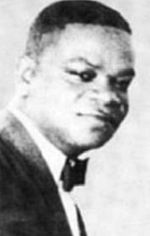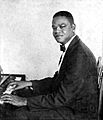Pixinguinha facts for kids
Quick facts for kids
Pixinguinha
|
|
|---|---|
 |
|
| Background information | |
| Birth name | Alfredo da Rocha Viana Filho |
| Also known as | Pizinguim, Bexiguinha, Pexinguinha, Pixinguinha |
| Born | April 23, 1897 |
| Origin | Rio de Janeiro, Brazil |
| Died | February 17, 1973 (aged 75) |
| Genres | Choro, Maxixe, Samba, Waltz, Jazz |
| Occupation(s) | Songwriter, composer, arranger, instrumentalist |
| Instruments | Saxophone, flute |
| Years active | 1911–1973 |
Alfredo da Rocha Viana Filho, known as Pixinguinha (born April 23, 1897 – died February 17, 1973), was a famous Brazilian musician. He was a composer, arranger, flautist, and saxophonist. Pixinguinha was born in Rio de Janeiro, Brazil.
Many people think Pixinguinha is one of Brazil's greatest popular music composers. He was especially important for a type of music called choro. He mixed old choro music from the 1800s with new sounds. These new sounds included jazz-like tunes, Afro-Brazilian rhythms, and complex arrangements. He helped make choro popular and showed it off as a unique Brazilian music style.
Pixinguinha was also one of the first Brazilian musicians to use new technologies. He used radio broadcasting and studio recording to share his music. He wrote many choro songs. Some of his most famous works are "Carinhoso", "Glória", "Lamento", and "Um a Zero".
Contents
Discovering Music: Pixinguinha's Early Life
Pixinguinha's father, Alfredo da Rocha Viana, was also a flautist. His father had many old choro songs and often hosted music parties at home. Pixinguinha learned to play the flute there. He also became a student of Irineu de Almeida.
Pixinguinha wrote his first song when he was just 14 years old. He made his first recording at age 16. In 1912, he started playing in clubs and shows in Rio de Janeiro. He then became the flautist for the Cine Rio Branco movie theater. At that time, silent movies often had live music. In 1914, he formed a group called Caxangá with his friends João Pernambuco and Donga. This group became quite famous before it ended in 1919.
Os Oito Batutas: A Revolutionary Music Group
In 1919, Pixinguinha, his brother China, Donga, João Pernambuco, and other musicians formed a new group. They called themselves Os Oito Batutas, which means "The Eight Amazing Players."
Their instruments were mostly traditional at first. Pixinguinha played the flute. The group also had guitars, a cavaquinho, a banjo cavaquinho, and hand drums. They played in the lobby of the Cine Palais movie theater. Soon, Os Oito Batutas became more popular than the movies themselves!
Their music included many styles. They played folk music from northeast Brazil, sambas, maxixes, waltzes, polkas, and "Brazilian tangos." The word choro was not yet a common name for the music style. The group was very popular across Brazil. They especially appealed to Brazilians who wanted a unique, homegrown music style.
Challenges and Success of Os Oito Batutas
Os Oito Batutas faced some challenges. Some people in Rio's upper class did not like black musicians performing in their venues. The group had both white and black musicians. They played in places where black musicians were usually not allowed.
Some critics felt that Brazilian music should only show its European roots. They thought a black musical ambassador was embarrassing. Pixinguinha's music style also faced criticism. He started using trumpets and saxophones, and some said his music was too much like American jazz. Jazz was becoming popular through radio at the time.
After a show, a wealthy man named Arnaldo Guinle discovered them. He helped them go on their first European tour in 1921. In Paris, they played for six months at the Schéhérazade cabaret. They were like ambassadors for Brazilian music. The tour was a big success. Pixinguinha received much praise from famous Parisian musicians.
When he returned to Brazil, they toured to Buenos Aires. There, they made recordings for RCA Victor. These recordings show the group's mature sound.
Pixinguinha came back from Paris with new musical ideas. He started adding jazz and ragtime songs to his group's music. He also changed the group's instruments. They added saxophones, trumpets, trombone, piano, and a drum kit. The group's name was changed to simply Os Batutas to show this new sound. Pixinguinha also bought a saxophone and started playing it himself.
Leading the Orquestra Victor Brasileira
In the late 1920s, RCA Victor hired Pixinguinha. He became the leader of the Orquestra Victor Brasileira. During this time, he became very good at arranging music.
Back then, choro musicians often made up their parts as they played. But radio music needed full written scores for every instrument. Pixinguinha was one of the few composers who could do this. In this role, he created some of his most famous songs. Well-known singers like Francisco Alves and Mário Reis helped make these songs popular.
Joining Lacerda's Conjunto Regional
In 1939, Pixinguinha left Victor. He joined flautist Benedito Lacerda's band. He started playing the tenor saxophone as his main instrument. He also continued to write music for the group.
Lacerda's band was a conjunto regional, or just regional. These were bands hired by radio stations. They played music and accompanied singers, often live for an audience. In the 1930s and 1940s, regionais gave steady jobs to the best choro musicians. This helped the Brazilian music industry become more professional.
With Lacerda, Pixinguinha had another busy period of composing and recording. Later, due to money problems, Pixinguinha had to sell the rights to his songs to Benedito Lacerda. Because of this, Lacerda appears as a co-composer on many of Pixinguinha's songs. This includes songs Pixinguinha wrote when Lacerda was a boy. In their recordings, Pixinguinha often played saxophone parts, while Lacerda played the flute parts.
Later Years and Legacy
By the mid-1950s, music tastes changed. Samba and American jazz became more popular in Brazil. The choro regional bands became less common on the radio. Pixinguinha spent his later years in retirement. He only appeared in public a few times, like on the "Evening of Choro" TV shows in 1955 and 1956.
Pixinguinha passed away in 1973. He died in the Church of Nossa Senhora da Paz in Ipanema while at a baptism. He was buried in the Cemitério de Inhaúma.
April 23 was thought to be his birthday for a long time. This day is now celebrated as the National Day of Choro in Brazil. It became an official day in 2000. This happened after a campaign by musician Hamilton de Holanda and his students. In 2016, it was found that Pixinguinha's real birthday was May 4. But Brazil's National Day of Choro still stayed on April 23.
Pixinguinha's Musical Style
Pixinguinha's music was more complex than older choro songs from the late 1800s. He used more advanced harmonies, rhythms, and counterpoint. Older songs were often for piano. But Pixinguinha's music used larger groups, like the regionais. He added detailed melodies, brass fanfares, and strong bass lines. His rhythms were also very lively.
Pixinguinha was one of the first band leaders to regularly use Afro-Brazilian percussion instruments. These include the pandeiro and afoxé. These instruments are now common in choro and samba music.
His arrangements were likely influenced by ragtime and American jazz bands. These styles became popular early in his career. When he released "Carinhoso" in 1930 and "Lamentos" in 1928, some people criticized him. They said he put too much jazz sound into his work. Today, these famous songs are respected parts of the choro music collection.
Pixinguinha's Compositions
- A pombinha (with Donga)
- A vida é um buraco
- Aberlado
- Abraçando Jacaré
- Acerta o passo
- Aguenta, seu Fulgêncio (with Lourenço Lamartine)
- Ai, eu queria (with Vidraça)
- Ainda existe
- Ainda me recordo
- Amigo de povo
- Assim é que é
- Benguelê
- Bianca (with Andreoni)
- Buquê de flores (with W. Falcão)
- Cafezal em flor (with Eugênio Fonseca)
- Carinhos
- Carinhoso (with João de Barro)
- Carnavá tá aí (with Josué de Barros)
- Casado na orgia (with João da Baiana)
- Casamento do coronel Cristino
- Céu do Brasil (with Gomes Filho)
- Chorei
- Chorinho no parque São Jorge (with Salgado Filho)
- Cochichando (with João de Barro and Alberto Ribeiro)
- Conversa de crioulo (with Donga and João de Baiana)
- Dança dos ursos
- Dando topada
- Desprezado
- Displicente
- Dominante
- Dominó
- Encantadora
- Estou voltando
- Eu sou gozado assim
- Fala baixinho (with Hermínio Bello de Carvalho)
- Festa de branco (with Baiano)
- Foi muamba (with Índio)
- Fonte abandonada (with Índio)
- Fraternidade
- Gargalhada
- Gavião calçudo (with Cícero de Almeida)
- Glória
- Guiomar (with Baiano)
- Há! hu! lá! ho! (with Donga and João da Baiana)
- Harmonia das flores (with Hermínio Bello de Carvalho)
- Hino a Ramos
- Infantil
- Iolanda
- Isso é que é viver (with Hermínio Bello de Carvalho)
- Isto não se faz (with Hermínio Bello de Carvalho)
- Já andei (with Donga and João da Baiana)
- Já te digo (with China)
- Jardim de Ilara (with C. M. Costal)
- Knock-out
- Lamento
- Lamentos (with Vinícius de Moraes)
- Lá-ré
- Leonor
- Levante, meu nego
- Lusitânia (with F. G. D. )
- Mais quinze dias
- Mama, meu netinho (with Jararaca)
- Mamãe Isabé (with João da Baiana)
- Marreco quer água
- Meu coração não te quer (with E. Almeida)
- Mi tristezas solo iloro
- Mulata baiana (with Gastão Vianna)
- Mulher boêmia
- Mundo melhor (with Vinícius de Moraes)
- Não gostei dos teus olhos (with João da Baiana)
- Não posso mais
- Naquele tempo (with Benedito Lacerda and Reginaldo Bessa)
- Nasci pra domador (with Valfrido Silva)
- No elevador
- Noite e dia (with W. Falcão)
- Nostalgia ao luar
- Número um
- O meu conselho
- Os batutas (with Duque)
- Os cinco companheiros
- Os home implica comigo (with Carmen Miranda)
- Onde foi Isabé
- Oscarina
- Paciente
- Página de dor (with Índio)
- Papagaio sabido (with C. Araújo)
- Patrão, prenda seu gado (with Donga and João da Baiana)
- Pé de mulata
- Poema de raça (with Z. Reis and Benedito Lacerda)
- Poética
- Por vôce fiz o que pude (with Beltrão)
- Pretensiosa
- Promessa
- Que perigo
- Que querê (with Donga and João da Baiana)
- Quem foi que disse
- Raiado (with Gastão Vianna)
- Rancho abandonado (with Índio)
- Recordando
- Rosa (with Otávio de Sousa)
- Rosa
- Samba de fato (with Baiano)
- Samba de nego
- Samba do urubu
- Samba fúnebre (with Vinícius de Moraes)
- Samba na areia
- Sapequinha
- Saudade do cavaquinho (with Muraro)
- Seresteiro
- Sofres porque queres
- Solidão
- Sonho da Índia (with N. N. and Duque)
- Stella (with de Castro and Sousa)
- Teu aniversário
- Teus ciúmes
- Triangular
- Tristezas não pagam dívidas
- Um a zero (with Benedito Lacerda)
- Um caso perdido
- Uma festa de Nanã (with Gastão Vianna) * Urubu
- Vamos brincar
- Variações sobre o urubu e o gavião
- Vem cá! não vou!
- Vi o pombo gemê (with Donga and João da Baiana)
- Você é bamba (with Baiano)
- Você não deve beber (with Manuel Ribeiro)
- Vou pra casa
- Xou Kuringa (with Donga and João da Baiana)
- Yaô africano (with Gastão Vianna)
- Zé Barbino (with Jararaca)
- Proezas de Solon
- Vou Vivendo
Images for kids
See also
 In Spanish: Pixinguinha para niños
In Spanish: Pixinguinha para niños


